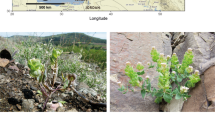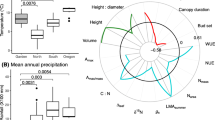Abstract
Amphicarpy is a form of diversified bet-hedging expressed mostly in annual plants, where two types of offspring are produced with two distinct ecological roles: long-range aerial dispersers and highly competitive subterranean, sedentary fruit. Emex spinosa is a semi-arid, amphicarpic annual, inhabiting habitats with different levels of environmental variation. We tested the hypothesis that, in E. spinosa, bet-hedging may be “fine-tuned” by plasticity in the phenotype ratio (aerial/subterranean fruit mass) as a function of environmental conditions. We conducted a greenhouse experiment, manipulating nutrient availability and intraspecific density, to determine the pattern of ratio shifts. In order to determine whether the integrated strategy is an adaptation to variable habitats, a similar common garden experiment was conducted, comparing two natural populations differing in environmental variability. The offspring ratio shifted in response to both nutrient availability and plant density. In pots containing single plants the ratio increased steeply with nutrient availability, while in pots containing eight plants a more moderate increase occurred. These shifts were the result of plasticity in allocation to both achene types, as well as ontogenetic effects on aerial achene production. The degree of response increased with the heterogeneity of the habitat of origin. We found evidence for an adaptive integrated strategy, with bet-hedging “fine-tuned” by phenotypic plasticity. Strenuous conditions tended to shift the offspring ratio towards securing subterranean reproductive success, while favorable conditions resulted in a shift towards dispersible achenes.






Similar content being viewed by others
References
Alpert P, Simms E (2002) The relative advantages of plasticity and fixity in different environments: when is it good for a plant to adjust? Evol Ecol 16:285–297
Bazzaz FA (1997) Allocation of resources in plants: state of the science and critical questions. In: Bazzaz FA, Grace J (eds) Plant resource allocation. Academic Press, NewYork, pp 1–37
Bell G, Lechowicz MJ, Appenzeller A, Chandler M, DeBlois E, Jackson L, Mackenzie B, Preziosi R, Schallenberg M, Tinker N (1993) The spatial structure of the physical environment. Oecologia 96:114–121
Blaustein L, Schwartz SS (2001) Why study ecology in temporary pools? Isr J Zool 47:303–312
Bulmer MG (1984) Delayed germination of seeds: Cohen’s model revisited. Theor Popul Biol 26:367–377
Cheplick GP (1987) The ecology of amphicarpic plants. Trends Ecol Evol 2:97–101
Cheplick GP (1994) Life history evolution in amphicarpic plants. Plant Species Biol 9:119–131
Cheplick GP, Quinn JA (1983) The shift in aerial/subterranean fruit ratio in Amphicarpum purshii: causes and significance. Oecologia 57:374–379
Cheplick GP, Kane KH (2004) Genetic relatedness and competition in Triplasis purpurea (Poaceae): resource partitioning or kin selection? Int J Plant Sci 164:623–630
Cohen D (1966) Optimizing reproduction in a randomly varying environment. J Theor Biol 12:119–129
Cohen D (1967) Optimizing reproduction in a randomly varying environment when a correlation may exist between the conditions at the time a choice has to be made and the subsequent outcome. J Theor Biol 16:1–14
Cohen D (1971) Maximizing final yield when growth is limited by time or by limiting resources. J Theor Biol 33:299–307
DeWitt TJ, Langerhans RB (2004) Integrated solutions to environmental heterogeneity. In: DeWitt TJ, Scheiner SM (eds) Phenotypic plasticity: functional and conceptual approaches. Oxford University Press, New York, pp 98–111
Evans GC (1972) The quantitative analysis of plant growth. University of California Press, California, USA
Evenari M, Kadouri A, Gutterman Y (1977) Eco-physiological investigations on the Amphicarpy of Emex Spinosa (L.) Campd. Flora 166:223–238
Evenari M, Shanan L, Tadmor N (1982) The Negev: the challenge of a desert. Harvard University Press, Cambridge
Gersani M, Brown JS, O’brien EE, Maina GM, Abramski Z (2001) Tragedy of the commons as a result of root competition. J Ecol 89:660–669
Gillespie JH (1977) Natural selection for variance in offspring numbers: a new evolutionary principal. Am Nat 111:1010–1014
Gillespie JH (1981) The role of migration in the genetic-structure of populations in temporally and spatially varying environments .3. Migration modification. Am Nat 117:223–233
Hairston NG (1989) Ecological experiments: purpose, design, and execution. Cambridge University Press, Cambridge
Harper JL (1977) Population biology of plants. Academic Press, New York
Hoagland DR, Arnon DI (1950) The water-culture method for growing plants without soil. University of California Agricultural Experimental Station, Berkley, Circ. 347
Lytle DA, Poff NL (2004) Adaptation to natural flow regimes. Trends Ecol Evol 19:94–100
Mandák B, Pyšek P (1999) How does density and nutrient stress affect allometry and fruit production in a heterocarpic species Atriplex sagittata (Chenopodiaceae)? Can J Bot 77:1106–1119
Mangel M, Clark CW (1988) Dynamic modeling in behavioral ecology. Princeton University Press
McConnaughay KDM, Coleman SJ (1999) Biomass allocation in plants: ontogeny or optimality? A test along three resource gradients. Ecology 80:2581–2593
Moran NA (1992) The evolutionary maintenance of alternative phenotypes. Am Nat 139:971–989
Murphy GI (1968) Patterns in life history and the environment. Am Nat 102:391–403
Nager RG, Van-Noordwijk AJ (1995) Proximate and ultimate aspects of phenotypic plasticity in timing of great tit breeding in a heterogeneous environment. Am Nat 146:454–474
Peters DPC, Havstad KM (2006) Nonlinear dynamics in arid and semi-arid systems: interactions among drivers and processes across scales. J Arid Environ 65:196–206
Philippi TE (1993) Bet-hedging germination of desert annuals—beyond the 1st year. Am Nat 142:474–487
Philippi TE, Seger J (1989) Hedging one’s evolutionary bets, revisited. Trends Ecol Evol 4:41–44
Philippi TE, Simovich MA, Bauder ET, Moorad JA (2001) Habitat ephemerality and hatching fractions of a diapausing anostracan (Crustacea: Branchiopoda). Isr J Zool 47:387–395
Rice SA, Bazzaz FA (1989) Quantification of plasticity of plant traits in response to light intensity: comparing phenotypes at a common weight. Oecologia 78:502–507
Roff DA (2002) Life history evolution. Sinauer Associates, Inc., Sunderland
Rood SB, Patino S, Coombs K, Tyree MT (2000) Branch sacrifice: cavitation-associated drought adaptation of riparian cottonwoods. Trees Struct Funct 14:248–257
Satake A, Sasaki A, Iwasa Y (2001) Variable timing of reproduction in unpredictable environments: adaptation of flood plain plants. Theor Popul Biol 60:1–15
Seger J, Brockmann HJ (1987) What is bet-hedging? Oxf Surv Evol Biol 4:182–211
Shachak M, Sachs M, Moshe I (1998) Ecosystem management of desertified shrublands in Israel. Ecosystems 1:475–483
Snyder KA, Tartowski SL (2006) Multi-scale temporal variation in water availability: implications for vegetation dynamics in arid and semi-arid ecosystems. J Arid Environ 65:219–234
Sultan SE (1995) Phenotypic plasticity and plant adaptation. Acta Bot Neerl 44(4):363–383
Venable DL (1985) The evolutionary ecology of seed heteromorphism. Am Nat 126:577–595
Venable DL, Brown JS (1988) The selective interactions of dispersal, dormancy, and seed size as adaptations for reducing risk in variable environments. Am Nat 131:360–384
Venable DL, Lawlor L (1980) Delayed germination and dispersal in desert annuals: escape in space and time. Oecologia 46:272–282
Venable DL, Dyreson E, Morales E (1995) Population dynamics consequences and evolution of seed traits of Heterosperma pinnatum (Asteraceae). Am J Bot 82:410–420
Venable DL (2007) Bet hedging in a guild of desert annuals. Ecology 88:1086–1090
Volis S, Mendlinger S, Ward D (2002) Differentiation in populations of Hordeum spontaneum Koch along a gradient of environmental productivity and predictability: plasticity in response to water and nutrient stress. Biol J Linn Soc 75:301–312
Weigelt A, Steinlein T, Beyschlag W (2005) Competition among three dune species: the impact of water availability on below-ground processes. Plant Ecol 176:57–68
Weiss PW (1980) Germination, reproduction and interference in the amphicarpic annual E. spinosa (L.) Campd. Oecologia 45:244–251
Zeide B (1978) Reproductive behavior of plants in time. Am Nat 112:636–639
Zohary M (1962) Plant life of Palestine. Ronald Press Company, New York
Acknowledgements
We would like to thank Rotem Ovadia, Matan Golan, Miranda Lipman and Noa Amram for their technical assistance. We are grateful to Joel Brown, Allan Witztum, Ariel Novoplansky, Burt Kotler, Shirli Bar-David, Yossi Guterman and two anonymous reviewers for their valuable insights. Special thanks to Yvonne Lipman for editing the manuscript. This paper is dedicated to our good friend, Gideon Raziel, who tragically passed away during the course of this study.
Author information
Authors and Affiliations
Corresponding author
Additional information
The authors Asaf Sadeh and Hagai Guterman contributed equally to this study.
Rights and permissions
About this article
Cite this article
Sadeh, A., Guterman, H., Gersani, M. et al. Plastic bet-hedging in an amphicarpic annual: an integrated strategy under variable conditions. Evol Ecol 23, 373–388 (2009). https://doi.org/10.1007/s10682-007-9232-2
Received:
Accepted:
Published:
Issue Date:
DOI: https://doi.org/10.1007/s10682-007-9232-2




